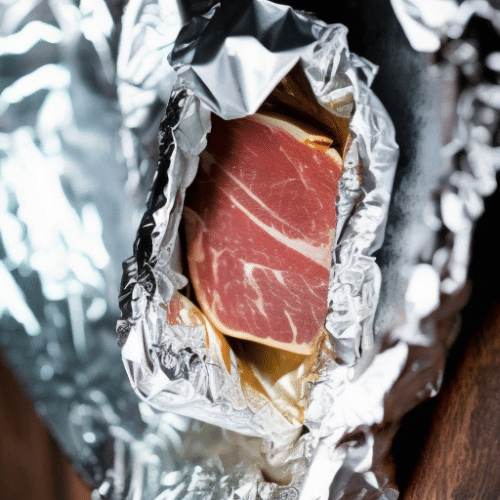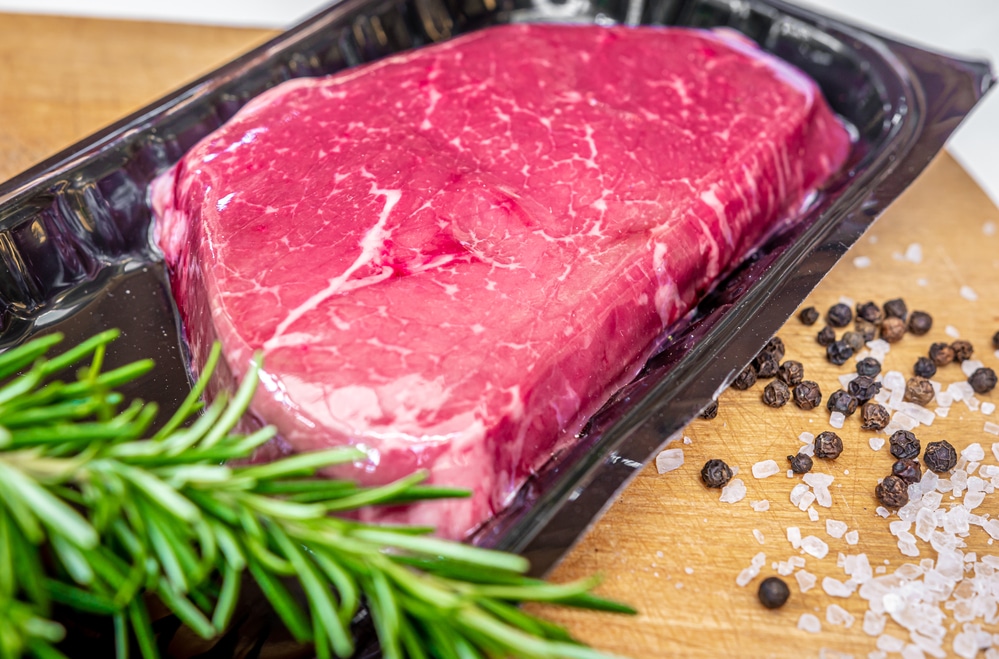Last Updated on
Do you wish to discover a method of preserving meat for a long period without using a vacuum sealer? You don’t need fancy equipment or complicated techniques. In this blog post, we’ll cover the basics of preserving your meats for long-term storage with just Ziploc bags, mason jars and aluminium foil. Whether it’s beef jerky or smoked salmon that needs sealing, these methods will help keep food fresh longer while saving you time and money in the process. So let’s dive into learning how to vacuum seal meat without a vacuum sealer.
Table of Contents:
- Vacuum Sealing Without a Vacuum Sealer
- Using Ziploc Bags for Vacuum Sealing
- Using Mason Jars for Vacuum Sealing
- Using Aluminium Foil for Vacuum Sealing
- FAQs in Relation to How to Vacuum Seal Meat Without a Vacuum Sealer
- Conclusion
Vacuum Sealing Without a Vacuum Sealer
Vacuum sealing is a great way to store and preserve food for longer periods of time. But what if you lack a vacuum sealer? Fortunately, there are still methods of achieving similar results without a vacuum sealer. Here’s what you will need: plastic freezer bags, mason jars with lids, aluminium foil and an iron or hair straightener.
One way to achieve vacuum sealing of meat without having to purchase an expensive sealer is by employing other methods, such as Ziploc bags. Let’s investigate the steps required for vacuum sealing meat using Ziploc bags in the following segment.
Using Ziploc Bags for Vacuum Sealing
Vacuum sealing food is a great way to preserve its freshness and flavour. Still, obtaining a vacuum sealer can be costly for some, making it out of reach. Luckily, there are other options for preserving food that doesn’t require the purchase of a vacuum sealer. One such method is using Ziploc bags for vacuum sealing.

For sealing with Ziplocs, you’ll need a bag that produces an air-tight seal when correctly shut. The best option here is freezer-grade bags, as they are thicker than regular storage bags and designed specifically for freezing food items. To ensure an airtight seal when closing your bag, make sure all the edges line up perfectly before pressing down on them firmly until you hear a click or feel resistance from the zipper closure mechanism.
Once your bag is sealed shut, you’ll need to remove any excess air from inside it so that no oxygen remains trapped inside your food item(s). To do this, simply submerge the entire bag into a bowl filled with cold water (make sure none of the water gets into your sealed bag) and press down gently on each side until all remaining air bubbles have been released from within it. Once done correctly, you should see small wrinkles form around each corner of your sealed Ziploc bag indicating that all oxygen has been removed successfully and replaced by nitrogen instead – preserving both taste and texture while preventing spoilage due to oxidation over time.
Ziploc bags are a great, cost-effective option for vacuum sealing meat without a machine. Mason jars, however, can offer a far more hermetic closure and be employed to store edibles either in the freezer or fridge. Let’s take a look at how to use them for vacuum sealing next.
Using Mason Jars for Vacuum Sealing
Mason jars are a great way to vacuum seal meat and other food items. They provide an impermeable barrier, preserving sustenance for extended spans of time. The size of the container you select should be contingent on the number of edibles you intend to preserve. Smaller jars work best for single servings, while larger ones can be used for bulk storage.
When utilising mason jars for vacuum sealing, it is critical to guarantee that all the air has been expelled from inside before shutting firmly with a top. To do this, fill the jar with your desired item and then press down firmly on top until no more air bubbles remain in the container. Once sealed, place the lid onto the jar and twist it shut securely so that no air can escape when storing or transporting your food items.
To ensure an even better seal, some people choose to add additional layers of protection such as wax paper or parchment paper, between their item and the lid before screwing it shut tightly. This helps create an extra barrier against oxygen getting into your stored goods which could cause them to spoil quickly if not properly sealed away from outside elements like moisture or heat exposure.
Mason jars are a great way to vacuum seal meat without the need for a vacuum sealer, and with just a few simple steps you can easily create an airtight environment that will keep your food fresh. Now let’s explore the potential of aluminium foil as a method for creating an airtight environment to keep food fresh, without requiring a vacuum sealer.
Using Aluminium Foil for Vacuum Sealing
Using aluminium foil for vacuum sealing is a great way to preserve food and keep it fresh for longer. It’s an easy, cost-effective alternative to buying a vacuum sealer. To achieve the most optimal results when employing aluminium foil for vacuum sealing, one must make certain to utilise heavy-duty material and form a hermetic closure.

When selecting your aluminium foil, look for heavy-duty or extra heavy-duty varieties as these are more durable than regular strength foils. Heavy-duty foils will also provide better protection against punctures or tears which can lead to leaks in the seal.
To create an airtight seal with your aluminium foil, start by wrapping the food tightly in several layers of the heavy-duty foil so that no air can escape through any gaps between layers of the wrap. Once all sides are securely wrapped, fold over each end of the package twice before crimping them together firmly with your fingers or a pair of pliers if necessary. Make sure there are no holes in either end as this could cause air leakage and spoilage of your food item faster than expected.
If you want added protection from moisture loss during storage, try adding some desiccant packets into each package before sealing it up with aluminium foil. Desiccants absorb excess moisture from within packages which helps prevent mould growth on stored items while keeping them fresher for longer periods of time.
Finally, be sure to label each package clearly with its contents and date so that you know what’s inside without having to open it up first. This will help ensure that nothing gets forgotten about at the back of your pantry cupboard or freezer drawer.
Vacuum sealing with aluminium foil is a great way to store food safely and keep it tasting delicious until ready for consumption – just remember not to skimp on quality when choosing your materials and take care when creating those seals.
FAQs in Relation to How to Vacuum Seal Meat Without a Vacuum Sealer
What can I use instead of a vacuum bag?
A vacuum bag is not the only option when it comes to cleaning up your home and garden. You can also use a handheld vacuum cleaner, which is more versatile and often easier to store away after use. Alternatively, you could opt for an upright or cylinder model that offers greater suction power but takes up more space in your home. For outdoor areas, consider using a leaf blower or blower vac – these are great for clearing leaves and debris from pathways quickly and efficiently. Finally, don’t forget about traditional tools such as brooms, dustpans and brushes; they may be old-fashioned but they still get the job done.
How do you use a vacuum bag without a vacuum?
Vacuum bags are a great choice for safeguarding possessions from dirt, moisture, and dust. Nevertheless, even if you don’t possess a vacuum cleaner, there are still methods to make use of the bags. For those without a vacuum cleaner, an airtight seal can still be achieved by pressing down on the bag’s opening with your hands or using a low-heat iron. Secondly, you can fill the bag with air by blowing into it through its opening or using a straw inserted into one of its corners. Finally, once sealed tightly enough that no air escapes when pressed against your hand or mouth, close the bag securely with either a zip tie or some tape for extra security. With these simple steps in mind, anyone can make use of vacuum bags without needing access to a vacuum cleaner.
Conclusion
Vacuum sealing meat without a vacuum sealer is possible with the right materials and methods. Ziploc bags, mason jars, and aluminium foil are all viable options for preserving your food in an airtight environment. Whether you’re trying to save money or just don’t have access to a vacuum sealer, these techniques can help you keep your meat fresh for longer periods of time. So next time you need to store some extra cuts of steak or chicken breasts, try one of these methods instead – it’s easy and effective. Learning how to vacuum seal meat without a vacuum sealer doesn’t have to be complicated; with the right supplies and knowledge, anyone can do it.
Paul is the type of person who never met a problem he couldn’t fix. He can always be found tinkering with something in his house, even if it isn’t broken! His tips and tricks are often shared on our site. He’s the one you call when something breaks because he has been known to improvise fixes for everything from leaky faucets to malfunctioning dryers.



